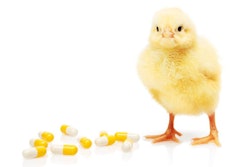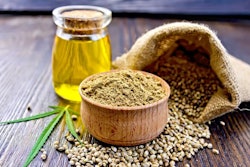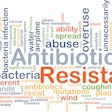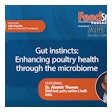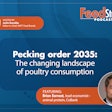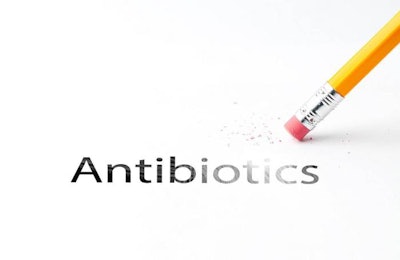
Learn about alternatives to antibiotics, the importance of gut health and what’s driving ABF production around the world.
PODCAST: Important factors in antibiotic-free production (12:47)
Ann Reus, Feed Strategy staff reporter: Hello and welcome to the Feed Strategy podcast. I’m Ann Reus, staff reporter for Feed Strategy.
Antibiotic-free poultry and livestock production continues to grow in the U.S. and around the world, partially driven by consumer demand. Today, approximately 60% of U.S. broiler production is antibiotic free, or ABF, and the broiler industry has paved the way for ABF production in other species.
I recently spoke with animal nutrition experts about antibiotic-free production. They talked about antibiotic alternatives, the importance of gut health, and the drivers behind ABF production around the world.
Let’s start off with Marilynn Finklin, technical services manager at Kemin Animal Nutrition and Health. She explains how phytogenics, probiotics and prebiotics work together to improve animal health.
Finklin: All of these products, they work together to improve the gut, and the overall health of birds. But I’m reluctant to say they’re a replacement for antibiotics, especially in their individual forms. These products are really, really important in gut health because you really want to be feed efficient; that’s the whole point in production. And the gut is also a gateway for many systemic – and also foodborne – illnesses for humans.
So, you want to achieve the same goal as you would with antibiotics, but you want to do it through other means. Ultimately, in order to accomplish this, you have to, either one, you have to control your intestinal challenge or – and – you need to control the body’s reaction to gut challenge. So, control intestinal challenge involves fighting off intestinal pathogens, like parasites, for example coccidiosis in poultry, but you also want to maintain your microbial balance.
So, when you give your probiotics, those microorganisms that you’re giving, they’re going to work indirectly through competitive exclusion to block out harmful bacteria and keep them from colonizing the gut but, also, they’re going to work directly by secreting antimicrobial substances.
And then, prebiotics, they enhance the growth of these same type of beneficial bacteria in the gut, again, helping to fight off those harmful bacteria.
And then phytogenics, they have many modes of action. They can be antimicrobial, they can be antiparasitic and, in addition to that, they can also work through immunomodulation and so, in that respect, they’re working on that second function, which is control the body’s reaction to gut challenge. And many times, though, because of the different modes of action, the probiotics, the prebiotics and the phytogenics, producers use a combination of those products to have optimal health.
Reus: And just how important is gut health in antibiotic-free production? Well, according to Jessika van Leeuwenn, global program manager for gut health at Trouw Nutrition, it is the most important thing in animal production.
van Leeuwen: The importance of gut health is actually the central role in this whole searching for alternative strategies because, first of all, gut health is – the health of the digestive system, let’s call it like that – gut integrity is important in order, first of all, to prevent any port of entry for pathogens.
Second of all, if that’s not working correctly, of course, we will not have optimal nutrient utilization, and if we have a very strong reaction of the immune system in the gut, we also utilize a lot of nutrients, so we can lose up to 30% of energy in inflammation processes in the gut. So, the key in this whole process is the gut, basically. That’s where the whole health of an animal or a human or any being, for that matter, starts.
Reus: And, adds Barbara Brutsaert, global program manager for poultry gut health at Trouw, the health of the intestine determines how well the animal’s immune response functions.
Brutsaert: So, it’s important also to focus on gut health in raising without antibiotics because most of the immune cells are situated in the gut. So, the healthier the intestines are, the better the immune system is functioning. Also, it helps in other diseases or other challenges, here for example, even respiratory.
Reus: Also important for producers: Finklin said good gut health contributes to good feed efficiency and, therefore, cost savings.
Finklin: Gut health, first off, is important in raising animals with or without antibiotics. It’s something that producers are going to focus on either way because, no matter the species, the goal is to produce as efficiently as possible in whichever production system that you’re in. Since feed is often the highest cost of animal production, and how well those animals convert feed into protein is the main concern so, in order to do that, you have to have your intestinal health in check, again by controlling those different disease pathogens, which can cause damage to intestines and prevent digestion and absorption.
So, much of the antibiotic use in antibiotic production was dedicated to this task and, without antibiotics being there as a tool, there’s much more focus on other ways to optimize that gut health. Additionally, many of the pathogens that enter in the intestines can also cause systemic disease, which can reduce your livability or your performance indirectly. And, also, antibiotics are helpful in controlling gut pathogens related to public health, like E. coli and Salmonella. So, we really have to increase that focus on gut health to control those diseases in antibiotic-free production and it’s even more dire in that situation.
Reus: The experts say it’s easier to produce broilers without antibiotics than other species such as pigs. Finklin says there are several reasons for this.
Finklin: In the regions where antibiotic-free meat is in demand, chicken is probably the most commonly eaten protein, or one of them, and therefore it was kind of a natural species to lead the way. In addition to that, I think, because chicken is still one of the most affordable proteins, it’s easy to have a larger market where people feel like they can afford antibiotic-free chicken, even if they’re just the typical family on a very typical income. So, while that cost of ABF chicken is higher compared to conventional chicken, it’s still relatively affordable.
I also kind of think that, because of the production cycle of chickens and their efficiency, it’s feasible for the producers to produce that chicken and still make a profit from raising chickens without antibiotics. For example, if you have a flock, too, that goes wrong – let’s say you have an outbreak of something like necrotic enteritis, in six weeks or so later, you can move on to the next flock. So, I think, from both the supply side of it and the demand side of it, I just think that there was the right combination there for it to thrive – ABF in the chicken world.
Reus: Brutsaert said it’s easier to find alternatives to antibiotics that work well in poultry than it is in other species.
Brutsaert: In poultry in general, most of the antibiotics – up to 80% even – are used for gut health disease. So, that way, it’s easier to find an alternative for antibiotics-free nutrition and feed additives while, in other species, a lot of antibiotics are also used for respiratory issues or other issues. In layers, more and more, gut health issues appear as they are kept for longer and even antibiotics use in layers is increasing, even in the Netherlands, so there it even becomes a bigger challenge.
Reus: And van Leeuwenn adds that the longer production cycle in swine adds challenges not seen in poultry.
van Leeuwen: It’s indeed true where, what we see in swine is, of course, we have a longer production cycle and, of course, a very different production cycle when I compare it to broilers. So, we have a lot of health challenges to tackle and that’s why the antibiotics are in there in the first place and, indeed, that’s not only gut-health related but there’s a lot of respiratory and systemic issues that we need to address there. So, that’s the reason why it’s a little bit more difficult to just substitute them one to one with alternatives.
Reus: Consumer demand is widely thought to be the main driving force behind antibiotic-free production. Finklin said factors such as health and fitness, as well as antibiotic resistance, are among the many reasons consumers choose ABF meat.
Finklin: I would say, certainly, consumer demand has been the primary driver behind ABF production and that’s either directly through making that choice in the supermarket to go for the ABF meat, or to be indirectly by choosing, for example, to frequent a fast-food operation that serves antibiotic-free meat.
So, this is perhaps driven by the focus of today’s consumers on their health and I think you have to understand who today’s consumer is. And I always like to look at the millennial generation because they’re especially driving the antibiotic-free meat demand as they’re really more conscious about lifestyle, fitness and health than previous generations. And, I think, as that generation starts to have children, they are going to want their families to also be very healthy and eat what they perceive to be healthy or natural foods. They also have concerns about antibiotic resistance, which also influences their choice to opt for antibiotic-free meat and, additionally, the millennial generation was also the first to grow up on social media and so they are widely influenced by peers and information they get on social media, and a lot of that information they get, whether it’s fact based or not, it focuses on eating these types of foods to lead that healthy lifestyle.
So, in order to satisfy the demand of these consumers today, antibiotic-free meat has to be a choice and, therefore, in order for the market to stay current, many of the producers have to offer, in part or whole, some type of antibiotic-free production.
Reus: Consumer demand for ABF meat varies by region as well, according to van Leeuwen, and is sometimes driven by a country’s export market demands.
van Leeuwen: We look at areas like North America and Europe, if I compare that to South America and maybe also Asia, in certain areas at least, there the customer opinion on antibiotic resistance and the use of antibiotics in general is not so strong yet. So, there, the reduction is really driven by customer demand coming from export markets, for instance, so if they want to export their product, they will have to follow by legislation in the areas that they export to. So, it’s another driver of the reduction of antibiotics, it’s not all customer driven, depending on the region where you are.
Reus: You can gain more insight from Finklin, van Leeuwen, Brutsaert and other experts in my article on antibiotic-free production in the March-April issue of Feed Strategy, available March 8. Thanks for listening, this is Ann Reus for Feed Strategy.

